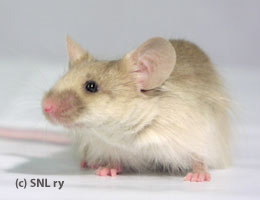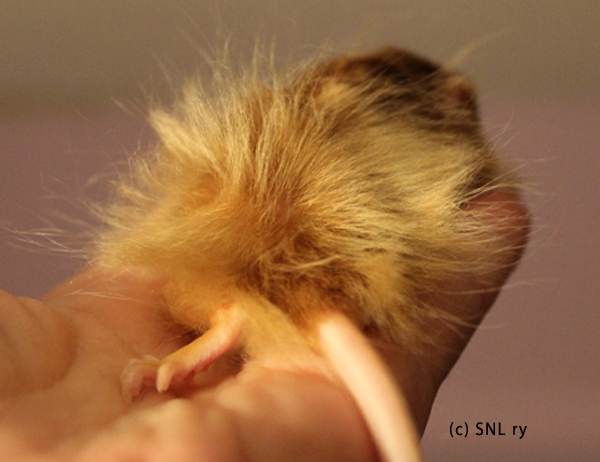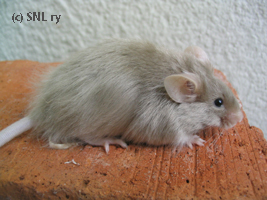Varieties
Coats
Long Hair
(long hair = LH, long hair satin = LHS)
go/go re/re Sa/* (Fr/* Fz/* ca/ca) (for 'shorter' long coat)
goY/goYre/re Sa/* (Fr/* Fz/* ca/ca) (for longer long coat)
"Coat to be as long and dense as possible, silky in texture. Bucks have usually longer coat than does."
Scroll down for lh astrex and lh satin astrex.
Breeding information below the pictures.
 |
LH marten sable buck Nice quality of coat. |

|
LH colorpoint beige buck Benson The hair could be considerably longer. |
Quick Look
The Long Hair mouse always has fans, which is no wonder considering the cuteness of the breed. A perfect Long Hair would have a thick and silky coat consisting of woolly and dense undercoat and even longer guard hairs forming a ?veil? at the armpits and the rump of the mouse. This ideal Long Hair mouse would also have good type and size, as well as keep its coat until old age.
The reality tends to be somewhat different. Good looking youngsters moult into looking like somewhat shaggy short hairs adults. Mice with a good veil lack length or density of undercoat. Those with a great and lasting coat aretiny, have a horrible type and/or colour that looks nothing like it should. As if to add insult to the injury, the best looking ones seem to pop up in all those matings when long hair is definitely not what you were looking for.
In spite of all this, a good Long Hair is well worth all the trouble!
Genetic Background
The scientific name for mouse long hair locus available for mouse fanciers is "fibroblast growth factor 5". In this locus, the alleles (in fanciers' parlance: genes) of importance for the breeder are angora, "Fgf5go", common symbol "go" and angora-Y, "Fgf5go-Y", common symbol "goY". This gene is located at chromosome 5.s
Both these genes are recessive to short coat. go gives the "common long coat", goY, which is higher on the dominance scale than go, gives "extra long coat".
Do note, that the while the difference between go and goY is noted in genetics sources, I can't say with absolute certainty that the notable differences in lengths of coats between mice from different locations of the world are due to some areas having goY in addition to go. However, those very same differences do support my theory. Besides, you can't simply breed a "common long hair mouse" to have as long hair as those mice who look like little powder puffs.
The most common gene available, go, gives a nice, long coat. Never as long as the coats of, say, longhaired hamster bucks, but still clearly long. The coat is at its best on young mice and gets slightly shorter with each molt. All hair of the mouse is elongated, with guard hairs gaining considerably more length than the undercoat. The hair growing longer is due to the hairs lacking one growth phase present in non-long coats: resting period, in which the hairs would not normally grow.
goY gives longer hair than go does. The growth phase of hairs is considerably longer than with go, resulting in hair that not only grows for a longer time, but also moults less often. As long hair mice get slightly shorter hair with each moult, fewer moults mean longer lasting long coat.
In More Practical Terms...
Long Hair is recessive to Short Hair and for best results are gained by breeding the best Long Hair mice together in order to build proper modifiers towards the best coat length into your mouse lines. While it isn't that hard to get the guard hairs long, getting the undercoat considerably longer can be problematic, so this is something to keep an eye on. One should aim for a good overall condition of the coat as well and not forget that good, dense coat gives the mouse a far more fluffier appearance. Yet another thing to breed for is a coat that lasts longer.
If one forgoes the type and size (and the quality of colour/markings), it is easier to get the desired coat. However, although a mouse with a very good long coat may get some allowance for type and size in shows, stick-on tails and tiny ears should not be tolerated.
The varieties that work the best in long hair are those with the most uniform colouring throughout the coat of the mouse and the single hairs of the coat. That is, self colours (with the slight exception of silver - due to the blueish undercolour). Ticked colours tend to have problems with the undercolour running too high up the hair and markings can have problems with the sharpness of the demarcation lines of the coat. Tanned varieties, especially non-ticked ones and of those, chocolate tan, can look quite delicious in the long hair varieties.
Other Long Hair Genes?
Angora and angora-Y aren't by far the only long hair genes mice have. However, the all of these genes are not available for mouse fanciers and some wouldn't give good looking mice even if they were. These other long hair genes include:
- long hair (lgh), a spontaneous recessive, chromosome 8. Identifiable from 5 weeks on. Guard hairs are long, but adult mice lack zig zag hairs (underhairs) on body, head and feet have normal coat. Mice also tend to get skin lesions.
- targeted mutation 1, Gail R. Martin (Fgf5tm1Mrt), targeted mutation, chromosome 5. Identifiable from 3 weeks on. Coat stays long, with all hair types 50% longer than on a short hair.
- skin/coat 6 (skc6), chemically induced recessive mutation, chromosome unknown. Gives long hair, but the coat is described as pale.
- skin/coat 8 (skc8), chemically induced recessive mutation, chromosome 15. Gives long hair.
Long Hair Satin (LHS)
go/go re/re sa/sa (Fr/* Fz/* ca/ca) (for 'shorter' long coat)
goY/goYre/re sa/sa (Fr/* Fz/* ca/ca) (for longer long coat)
"Coat to be as long and dense as possible, silky in texture. Bucks have usually longer coat than does." (Standards for Long Hair.)
"High sheen coat with a satin-like or metallic gloss. White to be known as Ivory and to be as white as possible." (Standards for Satin.)
Breeding information below the pictures.
Quick Look
Long Hair Satin is a charming breed, combining the sheen of a satin and the fluffiness of a long hair. LHS mice often look more pleasing to the eye than ?regular? LHs, as the coat looks exceptionally silky due to the satinization effect. Of course, satin does not have any effect at all on the length of the coat, so the breeder has to tackle that particular problem all the same.
Genetic Background
Long Hair Satin mice have:
- go/go (or goY/*), making them long hair instead of short hair and
- sa/sa, making them satin instead of non-satin.


